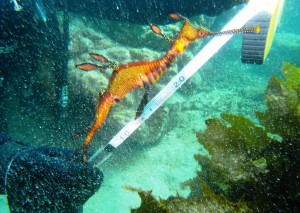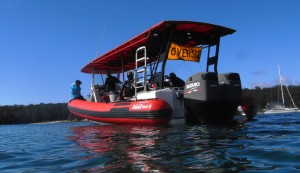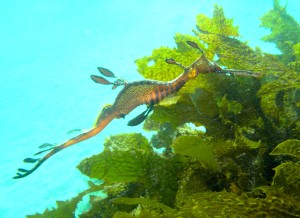Finding Dragons of the underwater variety
by Jillian Browning • August 14, 2014 • Announcements, Research • 0 Comments
On a cold and blustery day in August five volunteers braved the cold to go on an underwater expedition to find a dragon. Water temperatures of 13 degrees Celsius would not deter these brave souls from their mission. Luck was with them on this day as they were able to not only find a dragon but they found over 8 and managed to capture them on camera.
This dragon is none other than the Weedy Sea Dragon (Phyllopteryx taeniolatus), a beautiful and iconic fish; yes it is a fish, which is endemic to Australian waters. The Sea Dragon is related to the sea horses and lives amongst the weeds in southern Australia. It has appendages on its body that assists it in camouflage amongst sea weed; this is its only form of protection from predators.
It is a protected species in NSW waters; it is listed in the 1997 IUCN Red List in the Data Deficient category. Due to the categorisation of this species as data deficient scientists are now trying to gather data on as many populations in Australia to develop a deeper understanding of population sizes, longevity and breeding habits.
Professor David Booth from the University of Technology in Sydney is leading the research and has enlisted the help of local dive group the Sapphire Coast Underwater Research Group (SCURG) to collect photographic data and DNA samples from local populations of Weedy sea dragons. David Booth will be presenting at the Sapphire Coast Marine Discovery Centre Marine Science Forum in May, 2015.
 The SCURG dive team was able to find, photograph and collect tissue samples of the Twofold Bay Weedy Sea Dragon population that will be sent to David Booth for analysis. The photos are extremely important as they allow researchers to identify individuals within the population. Weedy Sea Dragons have vivid yellow spots on the side of their body in a pattern that is unique to each individual and work like a fingerprint. Scientists are able to use computer software to analyse the photos and recognise individuals. With dive surveys photographing the population over time the scientists will be able to estimate population sizes and longevity of the species in each location.
The SCURG dive team was able to find, photograph and collect tissue samples of the Twofold Bay Weedy Sea Dragon population that will be sent to David Booth for analysis. The photos are extremely important as they allow researchers to identify individuals within the population. Weedy Sea Dragons have vivid yellow spots on the side of their body in a pattern that is unique to each individual and work like a fingerprint. Scientists are able to use computer software to analyse the photos and recognise individuals. With dive surveys photographing the population over time the scientists will be able to estimate population sizes and longevity of the species in each location.
This dive would not have been possible without the generous contribution from the Merimbula Divers Lodge who has offered ongoing support to local marine research and the SCURG group.
Whilst under the water the SCURG team conducted research for a second project, two birds with one stone. As part of an ongoing Marine Ecology project run by the Atlas of Life and the Sapphire Coast Marine Society the divers set up data loggers to measure water temperature and thirty metre transect lines to record and monitor the sea weed in the area.
 These are both ongoing research programs and SCURG will be doing more dives locally to collect more data. If you are interested in being involved please find us on Facebook or email us education@sapphirecoastdiscovery.com.au.
These are both ongoing research programs and SCURG will be doing more dives locally to collect more data. If you are interested in being involved please find us on Facebook or email us education@sapphirecoastdiscovery.com.au.
